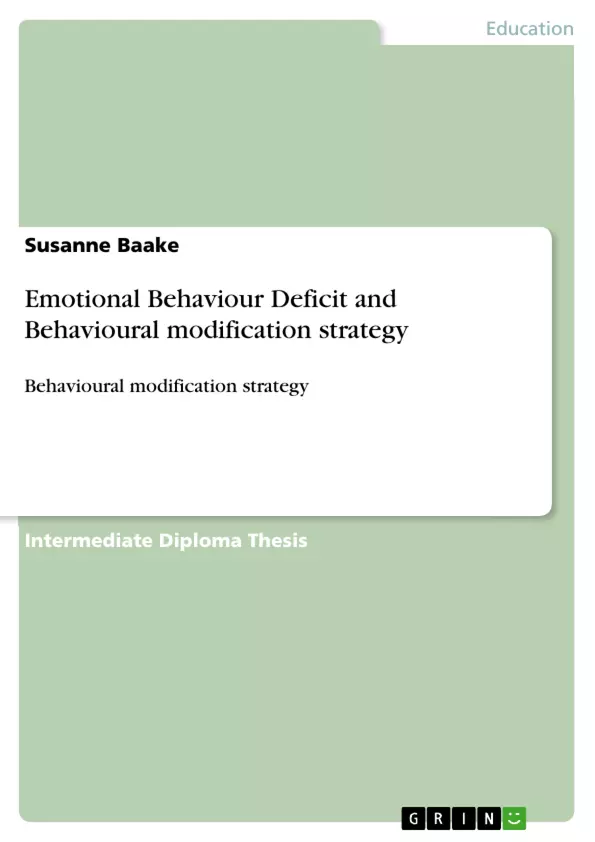Starting to implement those new findings already with children that show behavioural and emotional deficits will support them to grow up to be stable adults. Most important in such cases, is that educators as well as parents have to realize that the affected children have to be recognized as disabled and accordingly treated. Behavior and emotional deficits are not just a willing misbehavior from the child it is a disability.
Inhaltsverzeichnis (Table of Contents)
- Introduction
- Wexler David B. (1975). Behavior Modification and Legal Developments: CASE LAW QUESTIONS OF CONCERN CASES REFERENCE
- Bodenmann, G., Cina, A., Ledermann, T., & Sanders, M.R. (2008). The efficacy of the Triple P-Positive Parenting Program in improving parenting and child behaviour: A comparison with two other treatment conditions
- Crum Cherry F. (2004). Using a Cognitive-Behavioral Modification Strategy to Increase On-Task Behavior of a Student with a Behavior Disorder
- Gulchak Daniel J. (2008). Using a Mobile Handheld Computer to Teach a Student with an Emotional and Behavioral Disorder to Self-Monitor Attention
Zielsetzung und Themenschwerpunkte (Objectives and Key Themes)
This research project explores the use of behavioral modification strategies to address emotional and behavioral deficits (EBD) in children. The project aims to examine the historical development of behavioral modification methods, analyze the effectiveness of various approaches, and highlight the importance of early intervention and parent involvement in treating EBD.
- Historical Development of Behavioral Modification Strategies
- The Effectiveness of Different Behavioral Modification Approaches
- The Role of Parental Involvement in Treating EBD
- The Importance of Early Intervention for EBD
- The Use of Technology in Behavioral Modification
Zusammenfassung der Kapitel (Chapter Summaries)
- Introduction: This section provides an overview of the research project, highlighting the historical development of behavioral modification strategies and the need for effective interventions to address EBD in children. It emphasizes the importance of recognizing EBD as a disability and the need for appropriate treatment.
- Wexler David B. (1975). Behavior Modification and Legal Developments: CASE LAW QUESTIONS OF CONCERN CASES REFERENCE: This chapter explores the use of aversive techniques, such as electroconvulsive therapy and drugs, in the past to control behavior and emotional deficits. It examines real legal cases and discusses the ethical implications of such practices. The chapter highlights the shift towards positive reward therapy as a more promising approach.
- Bodenmann, G., Cina, A., Ledermann, T., & Sanders, M.R. (2008). The efficacy of the Triple P-Positive Parenting Program in improving parenting and child behaviour: A comparison with two other treatment conditions: This chapter analyzes the importance of parent-child relationships in influencing children's behavioral and emotional development. It examines the Triple P-Positive Parenting Program and its effectiveness in improving parenting skills and reducing child behavior problems. The chapter highlights the importance of preventive interventions and the need to consider the family context when addressing EBD.
- Crum Cherry F. (2004). Using a Cognitive-Behavioral Modification Strategy to Increase On-Task Behavior of a Student with a Behavior Disorder: This chapter explores the use of a cognitive-behavioral modification (CBM) strategy to increase on-task behavior in a student with a behavior disorder. It describes the implementation of a self-monitoring system and its effectiveness in reducing unwanted behavior. The chapter demonstrates the potential of CBM as a simple tool for teaching children to manage their own deficits.
- Gulchak Daniel J. (2008). Using a Mobile Handheld Computer to Teach a Student with an Emotional and Behavioral Disorder to Self-Monitor Attention: This chapter examines the potential of using mobile handheld computers to teach students with EBD self-monitoring skills. It questions the continued reliance on paper-based methods and highlights the benefits of incorporating technology into behavioral interventions. The chapter emphasizes the need for educators to embrace new technologies in addressing EBD.
Schlüsselwörter (Keywords)
The key themes and concepts explored in this research project include: emotional and behavioral deficits (EBD), behavioral modification strategies, positive reward therapy, parent involvement, early intervention, cognitive-behavioral management (CBM), preventive interventions, and the use of technology in behavioral interventions.
- Quote paper
- Susanne Baake (Author), 2009, Emotional Behaviour Deficit and Behavioural modification strategy, Munich, GRIN Verlag, https://www.grin.com/document/136814



